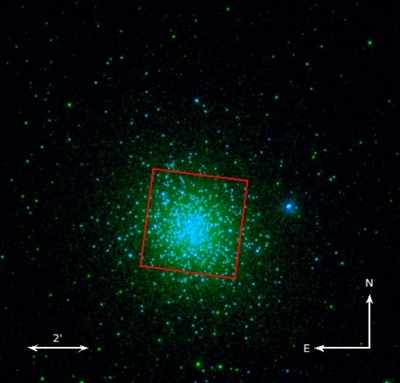- News
- Science News
- AstroSat helps spot UV stars in Milky Way’s cosmic dinosaur
This story is from January 21, 2021
AstroSat helps spot UV stars in Milky Way’s cosmic dinosaur
Astronomers from the Indian Institute of Astrophysics (IIA) have spotted rare hot Ultraviolet (UV)-bright stars in Milky Way’s massive intriguing globular cluster called NGC 2808 that is said to have at least five generations of stars. The team comprising IIA scientists Deepthi S Prabhu, Annapurni Subramaniam and Snehalata Sahu, captured these stars using Ultraviolet Imaging Telescope (UVIT) onboard AstroSat, India’s first multi-wavelength space satellite.

The UVIT image of NGC 2808 with the new detections in blue. (picture credit: IIA)
BENGALURU: Astronomers from the Indian Institute of Astrophysics (IIA) have spotted rare hot Ultraviolet (UV)-bright stars in Milky Way’s massive intriguing globular cluster called NGC 2808 that is said to have at least five generations of stars.
The team comprising IIA scientists Deepthi S Prabhu, Annapurni Subramaniam and Snehalata Sahu, captured these stars using Ultraviolet Imaging Telescope (UVIT) onboard AstroSat, India’s first multi-wavelength space satellite.In September 2020, AstroSat completed five years in orbit.
“These stars whose inner core is almost exposed, making them very hot, exist in the late stages of evolution of a Sun-like star. It is not clear how these stars end their lives as not many of them are detected in these fast-evolving phases, making this study crucial,” the team said.
IIA is an autonomous institute under the department of science and technology (DST). And, the DST said that motivated by the fact that old globular clusters — referred to as dinosaurs of the universe — present excellent laboratories where astronomers can understand how stars evolve through various phases between their birth and death, scientists specifically looked out for NGC 2808.
The scientists combined the UVIT data with observations made using other space missions such as the Hubble Space Telescope and the Gaia telescope along with ground-based optical observations. About 34 UV-bright stars were found to be members of the globular cluster. From the data, the team derived the properties of these stars such as their surface temperatures, luminosities and radii.
“One of the UV-bright stars was found to be about 3,000 times brighter than the Sun with a surface temperature of about 1,00,000-K (Kelvin). The properties of these stars were then used to place them on what astronomers call the Hertzsprung-Russel (HR) diagram along with theoretical models to throw light on the characteristics of their parent stars and to predict their future evolution,” the DST added.
Most of the stars were found to have evolved from a solar stage called the horizontal branch stars with hardly any outer envelope. Thus, the team said, they were bound to skip the last major phase of life called the asymptotic giant phase and directly become dead remnants or white dwarfs.
Such UV-bright stars are speculated to be the reason for the UV radiation coming from old stellar systems such as elliptical galaxies which are devoid of young blue stars. Hence, it is all the more important to observe more such stars to understand their properties.
The team comprising IIA scientists Deepthi S Prabhu, Annapurni Subramaniam and Snehalata Sahu, captured these stars using Ultraviolet Imaging Telescope (UVIT) onboard AstroSat, India’s first multi-wavelength space satellite.In September 2020, AstroSat completed five years in orbit.
“These stars whose inner core is almost exposed, making them very hot, exist in the late stages of evolution of a Sun-like star. It is not clear how these stars end their lives as not many of them are detected in these fast-evolving phases, making this study crucial,” the team said.
IIA is an autonomous institute under the department of science and technology (DST). And, the DST said that motivated by the fact that old globular clusters — referred to as dinosaurs of the universe — present excellent laboratories where astronomers can understand how stars evolve through various phases between their birth and death, scientists specifically looked out for NGC 2808.
“With spectacular UV images of the cluster, they distinguished the hot UV-bright stars from the relatively cooler red giant and main-sequence stars which appear dim in these images. The findings of this study have been accepted for publication in the journal ‘The Astrophysical Journal’,” DST said.
The scientists combined the UVIT data with observations made using other space missions such as the Hubble Space Telescope and the Gaia telescope along with ground-based optical observations. About 34 UV-bright stars were found to be members of the globular cluster. From the data, the team derived the properties of these stars such as their surface temperatures, luminosities and radii.
“One of the UV-bright stars was found to be about 3,000 times brighter than the Sun with a surface temperature of about 1,00,000-K (Kelvin). The properties of these stars were then used to place them on what astronomers call the Hertzsprung-Russel (HR) diagram along with theoretical models to throw light on the characteristics of their parent stars and to predict their future evolution,” the DST added.
Most of the stars were found to have evolved from a solar stage called the horizontal branch stars with hardly any outer envelope. Thus, the team said, they were bound to skip the last major phase of life called the asymptotic giant phase and directly become dead remnants or white dwarfs.
Such UV-bright stars are speculated to be the reason for the UV radiation coming from old stellar systems such as elliptical galaxies which are devoid of young blue stars. Hence, it is all the more important to observe more such stars to understand their properties.
End of Article
FOLLOW US ON SOCIAL MEDIA
